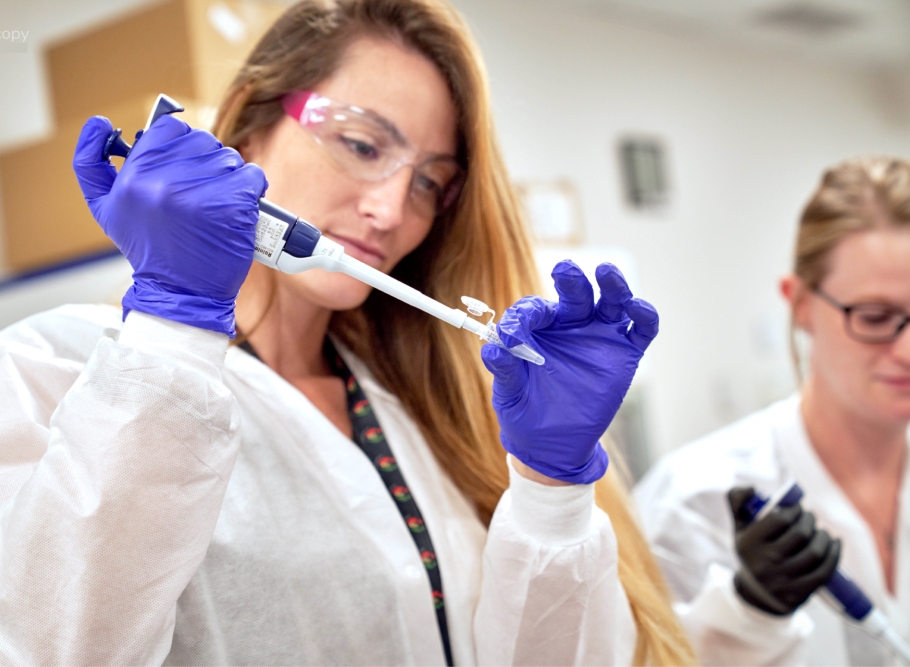
“Embrace your flaws: Everyone has flaws. I feel that I have been successful because I am able to recognize these flaws, understand where I need help, and fill in the gaps with resources and other people who are better than me in those areas. If you always assume you know everything or are always making the right decision you will be opening yourself up to failure in so many ways.”
Dr. Erica Barnell, Chief Science Officer and co-founder of Geneoscopy Tweet
Original interview – published in Health Care IT Today | July 26, 2023
Women comprise 70% of the healthcare workforce and 59% of medical, biomedical, and health sciences graduates, yet are the minority at leadership levels — holding only 25% of senior executive roles. As a result, the lack of women in significant decision-making positions is evident.
According to U.S. Census estimates, no single ethnic or racial group will represent a majority of the U.S. population by 2055. The potential for more positive patient care experiences, greater innovation, and improved organizational performance exists by creating more balance in healthcare leadership.
Existing Disparities and Challenges
Over a century ago, women founded, led, and operated hospitals. Today, they comprise most of the healthcare workforce — but not in leadership positions.
Women represent only 25% of top leadership roles in healthcare while holding an even lower percentage of corporate board seats (~14%) for publicly held life sciences companies. Within privately held companies, these numbers are even more underwhelming.
Despite significant advancements, we have a long way to go to address existing gender disparities in education and careers within STEM. As few as ten years ago, I was one of only a handful of women scientists in research labs and often the only woman in the boardroom. During presentations, I was asked more questions about my personal life than my business ideas — questions I have never heard asked of my male peers. Additionally, when defending research results, questions were often directed to my male peers even though I was the subject matter expert.
Gender Bias in Medical Research
Women’s health is often considered a niche area. But how can half the world’s population be considered niche? Of the nearly $42 billion the National Institute of Health (NIH) funds annually on health research, only $5 billion is spent studying women’s health issues in research labs led by men.
These numbers are consistent with female representation in clinical trials. On average, 41.2% of study participants are female. This number is often lower than the number of females typically diagnosed with the disease being studied. Unconscious biases can also significantly impact gender and racial equity in research studies. For example, a recent study showed that 80% of black women with breast cancer expressed willingness to participate in clinical trials; however, only 40% were included.
In colorectal cancer research, clinical studies have traditionally been held at large academic or endoscopy centers where patients typically have a colonoscopy scheduled, are health literate, and have insurance. This sample does not accurately reflect the population most at risk for developing colorectal cancer due to a lack of screening.
Researchers must adopt alternatives to traditional research methods to impact health equity positively. One approach is using decentralized recruitment efforts for clinical trials to support engaging diverse populations at greater risk for disease. For example, using social media to recruit study participants can help reach underserved communities and requires a low marketing dollar commitment. Decentralizing clinical trials can improve prevention and treatment for all populations, particularly racially and ethnically diverse communities.
The Importance of Women Leaders in Healthcare
Decades of research have shown that when women leaders are empowered to lead, everyone benefits. Fiscally, studies indicate that companies with women in top leadership positions are valued at $42 million higher than other companies. They generate a 10.1% return on equity annually versus 7.4% for those without female leadership.
When looking beyond the bottom line, including women in a leadership team increases a company’s global human capital wealth by 22%, with substantial health, social, and economic gains. The presence of women leaders helps achieve better results, including increased productivity, improved collaboration, greater commitment, and a fair work experience. Women are considered encouraging in a collaborative environment and are more honest, compassionate, outgoing, and creative.
What Does the Future Hold?
We are already seeing glimpses into the future with advances in digital technologies, including artificial intelligence, virtual and augmented reality, 3D printing, robotics, gene sequencing, and nanotechnology. As this unfolds, healthcare leaders must hire, train, and lead increasingly diverse teams of healthcare professionals along with teams from product development, training, tech, engineering, and manufacturing/construction to ensure inclusivity. But most importantly, leadership must align all decisions and directions to ensure the patient always comes first.
Witt/Kieffer discovered that 84% of survey respondents agreed that one of the best ways to support these endeavors is to establish mentorship programs that track to leadership roles. They offered these tips to create a successful mentorship program:
- Provide role models that help with advancement
- Develop a robust mentorship program
- Create internship opportunities
Advice For Future Women Healthcare Leaders
Trying to live up to someone else’s ideals will only cause you to sacrifice your own and block your path to the top. To be the best version of yourself, which includes being a fantastic leader, set your expectations and live up to those.
Here are three pieces of advice to guide you both personally and professionally:
- Be resilient and have humility: Adversity is a given. Keeping a positive attitude, being optimistic, controlling emotions, and seeing obstacles and failures as opportunities are keys to learning, improving, and growing.
- Look for opportunities, take risks, push yourself, and go for it: Successful leaders are proactive. Don’t wait for others to reach out to you – build and develop the relationships you need to make your goals happen.
- Success means finding YOUR balance: Life and work are often not in harmony in the real world. Living a successful and balanced life is more about knowing what motivates you and having tough conversations with people who matter most in your life.
While things are improving, there’s work ahead to close the gender gap in healthcare leadership. Prioritizing an inclusive and safe environment where people acknowledge the experience and expertise of women at all levels is essential to creating the culture shift necessary to make change happen throughout our industry.
 About Erica Barnell
About Erica Barnell
Erica Barnell graduated from Cornell University with a dual degree in Biological Sciences and Applied Economics & Management. Dr. Barnell completed her MD PhD at the Washington University School of Medicine with a PhD focus in Molecular Genetics and Genomics. Her thesis work surrounded the development of bioinformatics tools to alleviate the analysis bottleneck within precision oncology. Dr. Barnell has published 24 peer-reviewed manuscripts, four patents, and two book chapters within the oncology space. Dr. Barnell conducted the original research to validate Geneoscopy’s stool extraction method and managed all clinical studies for Geneoscopy’s colorectal cancer screening test. Dr. Barnell has contributed to the existing engagement with the FDA, which includes submitting a pre-market approval application, holding three presubmission meetings, completing BIMO/PAI audits, and obtaining Breakthrough Device Designation for the lead colorectal cancer (CRC) screening test. Dr. Barnell was named to the Forbes 30 Under 30 list in 2020 for her contribution to the Healthcare space.
